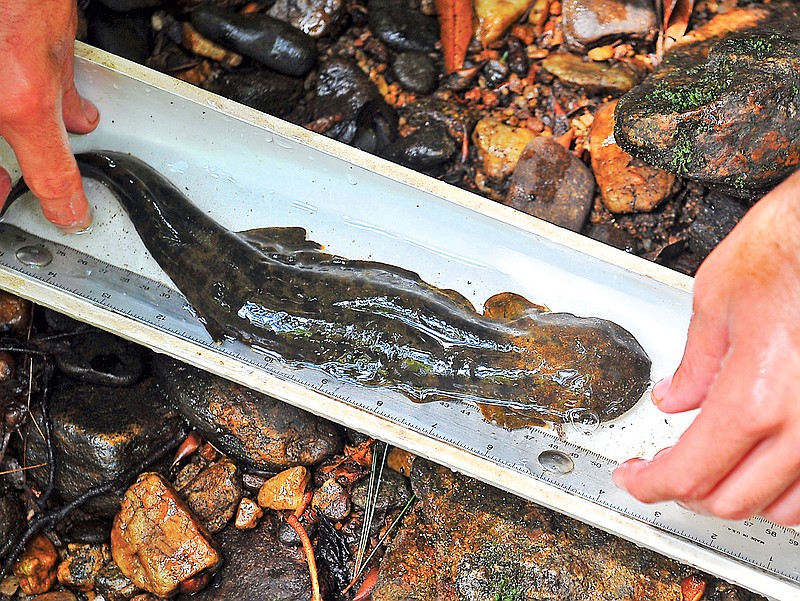MONTGOMERY, Ala. - What once was thought to have disappeared completely from the state's waterways has reared its slimy head once again.
Local scientists have been on a years-long hunt for the elusive - and large - hellbender salamander in Alabama's southern creek beds. Large, with a flat body, four short legs, toes, tail and baggy-brown skin the hellbender can grow up to five pounds and more than two feet long making it the third-largest aquatic salamander in the world and the largest in North America.
The hellbender was thought to have been completely eliminated from Alabama's waterways and has experienced a steep decline in population along the east coast from New York to Georgia since the 60s and 70s.
A team, led by James Godwin, an aquatic zoologist with the Auburn University Museum of Natural History's Alabama Natural Heritage Program, began searching for the Eastern hellbender in Alabama last year after reports of its existence in Butler County surfaced.
His quest came up dry last year, which has prodded Godwin to search for answers as well.
However, he has hope after a recent expedition this August, Godwin's team found a hellbender in a clean creek south of Montgomery.
"As scientists, we ask why," said Godwin. "What has brought about this decline?"
Based on observations, Godwin believes the disappearance of hellbenders may be directly related to a decline in water quality.
"We know that we used to have a nice intact forest with good leaf litter on the forest floor that would capture rain water and serve as a water filter, cleaning out debris like sand, silt, clay and other materials before slowly releasing the water into the streams," Godwin said.
"Hellbenders thrive in clean, cool streams, and a natural forest would both clean the water and keep the water cool by providing shade. As the forests are being cut, as the landscapes are changing, as there are more impacts upon the natural areas surrounding the creeks, more soil is being freed up and washed into the creeks with each rain event. The adults cannot survive if there is too much soil, sediment and silt coming into the stream system."
The construction of dams in the Tennessee River has also been a contributing factor by changing the water flow, eliminating creeks for the creation of lakes and inadvertently reducing the populations of crayfish and other small fish, which are the hellbenders' food source said Godwin, who has worked with the Alabama Natural Heritage Program for 24 years.
"All these things begin to add up," Godwin said. "So it becomes a loss-of-species snowball effect."
Alabama native, Jeff Garner, a biologist with the Alabama Department of Conservation and Natural Resources Division of Wildlife and Freshwater Fisheries and several scientists from the ADCR loaded up kayaks and canoes and headed to Butler County this summer to explore remote sections along Butler Creek.
Hellbenders flourish in swift-moving, clear streams or river with rocky bottoms. Butler Creek fit the description so the team waded into the creek and began searching the creek's bottom, feeling under rocks.
It wasn't long before one of the team members found a hellbender hiding in the crevice of a rock. One by one, the scientists took turns diving under the water shining their flashlights to catch a glimpse.
Since then, Godwin has moved his search down Sugar Creek and continues to research the hellbenders through funding from the Alabama Department of Conservation and Natural Resources and a multi-state grant from the U.S. Fish and Wildlife Service.
Godwin's mission has ultimately become about providing cleaner waterways for not only the hellbender, but people as well.
"If we could find ways to bring about improvements in our streams so that we have the natural ecological filtering systems back in place, it would improve water quality for the hellbender," Godwin said. "It would improve water quality for the mussels, the fish, the insects, the crayfish, and it would improve water quality for us.
"The need for good water quality links us all together. So, for our own good, we need to think about why we are losing hellbenders, look for solutions and implement those solutions."
